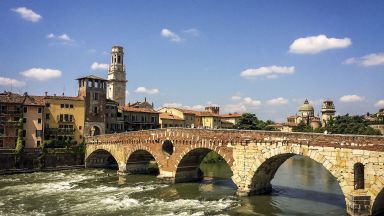Museo Archeologico al Teatro Romano
Historic Building and Museum in Verona

The archaeological museum at the Roman theater is a large museum complex located in the Veronetta district of Verona , near the bend of the Adige river ; it is made up of Palazzo Fontana, which serves as the entrance to the large area, the archaeological site of the Roman theater in Verona and the actual museum, located in the 15th century convent of the Gesuati.
The Roman theatre of Verona (Italian: Teatro Romano di Verona) is an ancient Roman theatre in Verona, northern Italy. It is not to be confused with the Roman amphitheatre known as the Verona Arena.The theatre was built in the late 1st century BC. Before its construction, two walls were built alongside the Adige River, between the Ponte di Pietra and the Ponte Postumio, to protect it against floods. Today only remains of the edifice are visible, recovered starting from around 1830. They include the cavea and the steps, several arcades of the loggias and remains of the stage. Part of the cavea was occupied by the church of S. Siro, built in the 10th century and restored in the 14th century. At the top of the hill there was an ancient temple, built on a series of terraces.
The archaeological collections that would later become part of the material available to the archaeological museum at the Roman theater, were previously deposited, at least since 1857, at the civic museum which was located inside Palazzo Pompei , a building designed by the Renaissance architect. mannerist Michele Sanmicheli and located near Porta Vittoria .
The first archaeological finds came from private collections that were donated to the Municipality of Verona over the years, but in particular in the nineteenth century, by important Veronese families. Particularly precious were therefore the donations that went to form the first catalog, the work of Giovanni Fontana, whose legacy included many decorative elements and statues from the theater area, by Giacomo Verità, whose collection included Etruscan urns, bronze statues, Greek oil lamps and vases, and the donations of numerous epigraphs by Girolamo Orti Manara and Antonio Smania.
Subsequently, the Municipality worked hard to purchase several other collections, including that of Jacopo Muselli , which included objects in glass, terracotta and bronze, that of the archaeologist Bernardino Biondelli , including Etruscan vases, and the collection of ceramic vases. of the Lazise-Gazzola family, while Carlo Alessandri, in 1895, donated his large collection of statues, vases, bronze statuettes and glass objects. To these collections were added other finds found in the course of archaeological excavations carried out in the city and in the province of Verona .
Finally in 1904 the Municipality bought, from the heirs of Andrea Monga, the whole area on which the archaeological site of the theater stood, including the buildings that stood there and the archaeological collections of epigraphs and decorative and architectural elements coming from the excavations carried out in the same area . The archaeological museum was thus established in 1924 and found its seat in the fifteenth-century convent of the Gesuati, a complex that dominates the area of the Roman theater from above and which was suppressed by a Napoleonic decree in 1805.
After the museum set-up created during the 1930s, the museum was no longer the subject of major construction sites for many years. Only in the seventies there were some restorations, but more important works of consolidation of the structures and the renewal of the museum layout were carried out only between 2013 and 2016, when the museum was thus reopened to the public with an updated museographic look.
The Museo Archeologico al Teatro Romano appears in our Complete Guide to Visiting Verona!
This website uses affiliate links which may earn a commission at no additional cost to you!
Visiting Museo Archeologico al Teatro Romano
8.30am-7.30pm Tue-Sun, 1.30-7.30pm Mon
adult/reduced €4.50/3, with VeronaCard free
Nearby Attractions
- Castel San Pietro (0.1) km
Castle in Verona - Ponte Pietra (Verona) (0.2) km
Bridge and Historic Site in Verona - Sant'Anastasia, Verona (0.3) km
Church in Verona - Duomo di Verona (0.4) km
Cathedral in Verona - Arche Scaligere (0.5) km
Tomb in Verona - Loggia del Consiglio (0.5) km
Historic Building in Verona - Piazza della Signoria (0.5) km
Square in Verona - Palazzo Miniscalchi (0.5) km
Museum in Verona - Torre dei Lamberti (0.6) km
Tower in Verona - Piazza Delle Erbe (Verona) (0.6) km
Square in Verona


